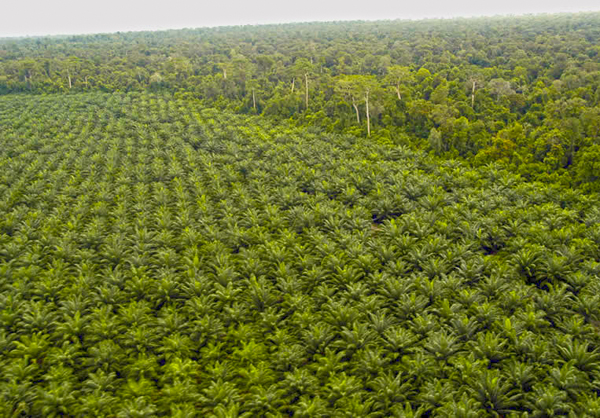Businesses and advertisers like to play on the “eco-friendiness” of their product, but the reality is less attractive. [26 March 2013 | Peter Boyer]

A plantation of oil palms next to virgin rainforest in Borneo. The clearing of rainforest in Borneo and Sumatra for timber and palm oil is a major threat to the survival of orang-utans in the wild. SOURCE: theitinerant.co.uk
A good-looking young runner moves in slow motion along a forest path shaded by tall trees and bathed in dappled sunlight, as a voice talks about “a gift from nature, a gift for life.”
The world may know almost all Earth’s wonders, says the voice in the TV ad, but “many may not be aware of the wonders of this gift from nature.” The “gift” is Malaysia palm oil, “sustainably produced since 1917”.
Oil palm plantations are a familiar sight in the countryside of Malaysia, which shares with Indonesia the mantle of world’s leading producer of palm oil, in strong demand globally as a food additive and a cheap source of cooking oil.
Another “gift from nature” is palm-oil biofuel. Plans are well advanced for a Finnish-funded processing plant in Singapore which its advocates claim will meet current world demands for biodiesel made from Malaysian palm oil. You can’t get greener than that, surely?
The truth is more complex. While biomass can be a good option for local energy needs where the supply of plant material is strictly controlled, supplying biofuel in anything like the quantity needed to meet world transport needs would swallow up huge tracts of forest or food-producing farmland.
To make way for lucrative palm oil plantations the Malaysian government has sanctioned clearing of over 50,000 square km of forest. With a single oil palm species replacing some of the world’s most species-rich natural habitats, the consequences for biodiversity are devastating.
Consequences may be fatal for the orangutan, Asia’s only great ape whose numbers in the wild are perilously close to zero. Clearing of forest for timber and palm oil has decimated the animal’s remaining habitat in Indonesia and Malaysian Borneo. Palm oil has been called “orangutan tears”.
We don’t hear about any of this in the ads. Just as we don’t hear about the environmental costs of transporting bottled water halfway round the world (or bottling water at all), or tanning “natural” leather, or making smartphones or synthetic fibres or — the list is endless.
Take tourism. The ads tell us how eco-tourism enables us to preserve wild places, as an alternative to their destruction by mining or logging. This is true as far as it goes, but there’s a lot they don’t touch on.
They don’t talk about the environmental cost of getting people from their homes to the beautiful places and back again. Each day the growing global airline industry uses billions of litres of fuel, with a correspondingly huge carbon footprint.
Aviation’s current contribution to man-made warming is about 3.5 per cent of the total. Using industry growth forecasts, the IPCC estimated that by 2050 aviation could be contributing as much as 15 per cent of our total carbon footprint — or more if emissions from other activities are cut.
So before they’ve even started their tour, most of the world’s “eco-tourists” have been responsible for the release of a huge amount of carbon into the atmosphere.
My own experience tells me that whatever thoughts they might have had about carbon emissions disappear in a puff of smoke when they see what they came for. Some of these places are breathtaking, and none more so than the spectacular sea coasts of south-east Tasmania.
Tourism which brings people closer to our island’s natural wonders is worth having. I’ve been on a boat cruise along Bruny Island’s sea coast, and it was worth every penny. I don’t question the value of the experience, or the good intentions of those who operate the tours.
But I do question what we mean when we apply the tag “eco-tourism” to businesses like these. Carrying people close to rocky shores in open sea, these boats need to be nimble and capable of rapid acceleration.
This means powerful motors. Each of the vessels operated by two companies around Tasman Peninsula and Bruny Island is driven by either three or four 300-horsepower outboards.
Fuel economy varies according to engine configuration and conditions, but according to one independent boat test the best cruising efficiency for the three-motor arrangement is 132.5 litres of fuel per hour.
For a three-hour cruise that amounts to nearly 400 litres of unleaded petrol, a litre of which releases 2.3 kg of carbon dioxide when burned. So in a single three-hour trip, one vessel releases close to a tonne of carbon dioxide — roughly what it takes 40 healthy mature trees to absorb in a year.
One of the operators, Rob Pennicott, says on his company website that his “100 per cent carbon offset business is Ecotourism Australia Accredited and is a Green Globe Lite Operator with above best practice scores for its efficient fuel, water and waste practices.”
He points out that the company has an agreement with Greening Australia, involving planting in the upper Derwent, that aims to improve river system health by reducing sediment to create healthier habitats for river and estuary species, while also providing employment for forest workers.
I applaud Rob Pennicott for his effort both to familiarise people with our splendid natural assets and to offset the emissions from his business. It’s a lot more than others are doing (in most cases, zero), and it underlines why he has won accolades as an advocate for environmental awareness.
I think he would be the last person among our tourism operators to want to conceal from his customers any uncomfortable realities, which is why I respectfully suggest that he, along with the rest of the tourism industry, should rethink the “ecotourism” tag.
Or perhaps he should go for the slower and less nimble, but much more “eco-friendly”, option of sail.
